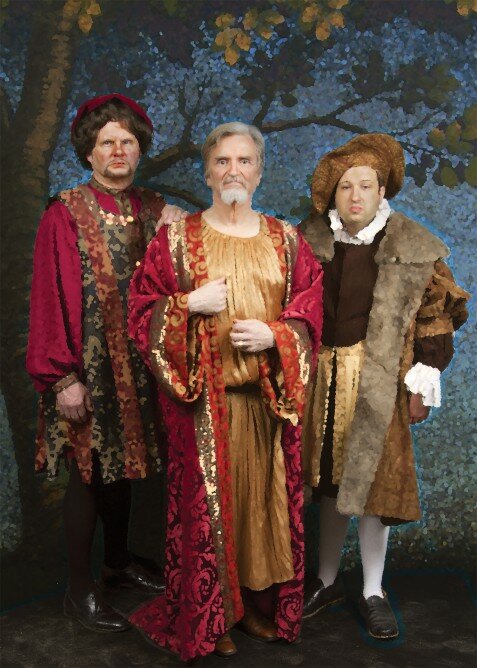When Gilbert and Sullivan planned a comic opera to follow their wildly successful Mikado, they decided on an old-fashioned melodrama, or as they described it, an “Entirely Original Supernatural Opera.” Ruddigore was the result, and though it has never reached the heights of popularity that The Mikado, H.M.S. Pinafore, and The Pirates of Penzance have unflaggingly reached for upwards of 120 years, Ruddigorehas a charm of its own.
The Seattle Gilbert & Sullivan Society‘s production of Ruddigore runs weekends, July 15 to July 30, for eleven performances at Bagley Wright Theatre (tickets $40 regular, with discounts for senior citizens and under-18).
Ruddigore is the only G&S with an inherited curse and ghosts who come to life from their painted portraits, and as usual in Seattle’s annual offering, this production is replete with imaginative touches impossible in the 1880s. Dubbed “Bloodygore” by wags at the time, there isn’t much actual blood.
The story is of a family cursed for generations with the inheriting baronet having the obligation to commit a crime a day, enforced by the ghosts of the ancestral family portraits. The current baronet runs away and returns in the guise of a villager, leaving his crime responsibilities and title to his brother. The ruse is discovered and the errant heir forced to resume his rightful role.
The portraits, which are truly painted ones, metamorphose into moving, speaking figures stepping out of their frames. One even descends slowly to floor level from his portrait above the fireplace to berate his newly discovered descendant. There is of course a heroine, also a madwoman, an old retainer and the seafaring foster brother as well as a chorus of professional bridesmaids frustrated by the lack of brides.
Few people at Seattle G&S are paid. Producer Mike Storie, who with this show will have produced the entire G&S canon, is working with about 125 volunteers, from singers to photographers to set and costume builders.
“You need a different management skill when you are working with volunteers,” he says, citing useful experiences from apprenticeship to his blacksmith grandfather to intelligence work in Berlin, to the early days of computers to ocean going racing with a volunteer crew. “You had to recruit 15 people, get them to pay to get there, tell them they will throw up a lot for two weeks and then have the time of their lives. That’s how I learned to manage people you can’t give a bonus to.”
Those who find their way to Seattle G&S get hooked. Many have been with the company in a variety of front and back stage positions for 20-, 30-, 40-plus years, Storie since 1968, carpenter Gary Webberley doing his 47th show. Many of their spouses join in too.
In an inspired fundraising move, Seattle G&S auctioned off secondary portrait roles for Ruddigore, and for every performance two of those will be patrons. “I wish we could do this every year,” says Storie. The patrons dressed in costume and were photographed by volunteer Patrick André, and these were photoshopped into seemingly painted lifesize portraits by volunteer Rich Bower.
Even more authentic, two of the portrait people have been dead for some years, but one senses they would have been delighted to contribute themselves to yet another production. Their daughters bought the portrait appearances at the auction. One had been photographed as a portrait in the 1995 production and his photo was duly produced and turned into a painting for this year. The other used a fine photo of the decedent’s head and photoshopped it onto the costumed body of another man. You’d never know.
Several longtime favorites are back: radio personality Dave Ross as Sir Despard the wrongful baronet; Robin the absconding one is John Brookes; Hollis Heron, a high-powered electrical engineer in the daytime transforms into Mad Margaret, with a scene which could upstage Ophelia, and William J. Darkow as leader of the ghosts, Sir Roderic Murgatroyd.
Some have stepped out of the chorus to solo roles. “Derek Sellers knocked our socks off,” says Storie, for the role of the seafaring foster brother, Richard Dauntless, “he had the accent, the character, the dance—he has an extended hornpipe. It’s wonderful.” There are folk dances and a 12-foot maypole as well.
It takes months to put together Seattle G&S productions, but the standard is consistently and amazingly high for a company which considers itself a volunteer outfit, while the orchestra under music director Bernard Kwiram supports it all with Sullivan’s irresistable melodies.

